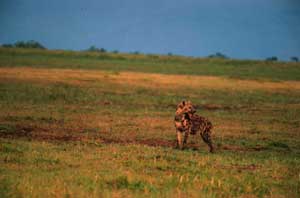|
|
 67 and their predators DHJanzen100231.jpg high resolution
|
|
| Zebras live in herds, probably in great part for protection as well as social interactions. Their contemporary predators - lions, hyenas (image DHJanzen100231.jpg), hunting dogs, leopards - hunt from day to dusk to full dark (though sometimes with moonlight). A healthy adult zebra in full possession of its senses can kill or permanently cripple any of these predators by kicking. Analysis of prey indicates that nearly all the zebras taken are pregnant, or old, or crippled, or sick, or very young - you get the picture. Then why the black and white color pattern? (Incidentally, they all only LOOK the same - in fact, each has a unique pattern of detail in the stripes). It is very likely that a large part of the hunting method by any to all of the predators is to study the members of the herd until they notice an animal that is susceptible, and then attempt to direct the attack on that animal. Now, just try to keep track of an individual zebra in a milling, running, turning, churning herd of zebras, and especially in the lower light intensity of dusk (or worse, moonlight). That black and white patterning enables any given individual to blur into the herd as a whole, and I suspect gives the fleeing individual just a bit of an edge, if not a lot of an edge. Any zebra mutant that began to drift away from this color pattern would be an easy mark indeed. In effect, the target zebra is mimicking the entire herd of healthy animals. | ||
back to lecture slides
or skip to: